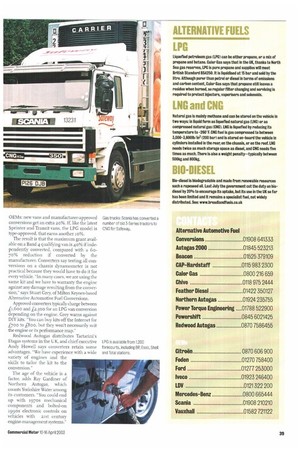LPG CONVERSIONS
Page 38

Page 39

If you've noticed an error in this article please click here to report it so we can fix it.
• LPG conversions are only done on petrol engines. Many vans running on LPG are hifuel: able to run on either petrol or LPG. The engine starts up on petrol and then switches to LPG automatically. The driver can also switch between the fuels manually by flicking a switch on the dashboard.
Early LPG conversion kits were quite crude, comprising mainly a vaporising unit with an open loop control. Next came single-injection systems, which had an open-closed loop and microprocessor control.
Cases of gas engines backfiring and even blowing inlet manifolds were probably due to lack ofcontrol over the gas/air mix, according to the converters. On newer vans, single-injection systems have been superseded by electronic multi-point systems.
Sequential gas injection (SGI) multi-point systems are designed to work with the latest generation of petrol engine management systems, which incorporate on-board diagnostics and emissions control.
Gas flows through a common rail to the SGI injectors, which are attached to the inlet manifold. Each injector is controlled individually to give optimum timing. The SGI computer calculates the desired injection moment and the duration of injection for each cylinder.
Dutch companies AG Autogas, NecamVoltec, Tartarini and Vialle, and Italian manufacturer B RC supply many of the LPG conversion kits available in the UK—not surprising, perhaps, given that the Dutch and Italian markets are two of the largest for gas-fuelled vehicles in Western Europe. UK-based Beacon Technology also supplies its own conversion kits for older vans, but is now concentrating on distributing the Necam-Voltec system.
If you want to offset capital cost with a Powershift grant, you must apply for it before buying the vehicle. Powershift's approved vehicle register lists which kits have been approved for particular vans. If you decide to use a different conversion kit, it may not attract the same percentage grant—or any grant at all.
The Powershift rules for vehicles under 3.5tonnes gross are complicated, except for Scottish operators who can claim a flat goo grant for any multi-point gas conversion. In the rest of the UK, vehicles are banded according to whether the conversion matches or betters Euro-3, 4 or 5 emissions levels, but the amount also depends on which Euro level the base petrol engine meets. The rules favour the
OEMs: new vans and manufacturer-approved conversions get an extra zo%. If, like the latest Sprinter and Transit vans, the LPG model is type-approved, that earns another ro%.
The result is that the maximum grant available on a Band 4 qualifying van is 40% if independently converted, compared with a 6o70% reduction if converted by the manufacturer. Converters say testing all conversions on a chassis dynamometer is not practical because they would have to do it for every vehicle. "In many cases, we are using the same kit and we have to warranty the engine against any damage resulting from the conversion," says Stuart Grey. of Milton Keynes-based Alternative Automotive Fuel Conversions.
Approved converters typically charge between £1,600 and £2,300 for an LPG van conversion depending on the engine. Grey warns against DIY kits. You can buy kits off the Internet for £700 to p00, but they won't necessarily suit the engine or its performance map."
Redwood Autogas distributes Tartarini's Etagas systems in the UK, and chief executive Andy Howell says converters retain some advantages. "We have experience with a wide variety of engines and the skills to tailor the kit to the conversion."
The age of the vehicle is a factor, adds Ray Gardiner of Northern Autogas, which counts Yorkshire Water among its customers. "You could end up with 1970s mechanical components and bolted-on 1990s electronic controls on vehicles with zist century engine-management systems."








































































































































































